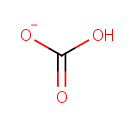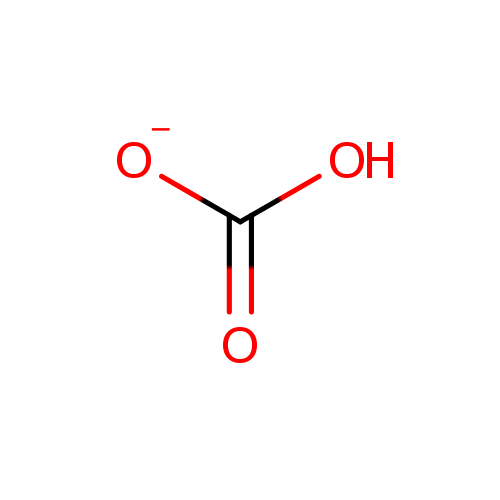
Hydrogen carbonate (PAMDB000153)
| Record Information | ||||||||||||||||||||||||||||||||||||||||||||||||||||||||||
|---|---|---|---|---|---|---|---|---|---|---|---|---|---|---|---|---|---|---|---|---|---|---|---|---|---|---|---|---|---|---|---|---|---|---|---|---|---|---|---|---|---|---|---|---|---|---|---|---|---|---|---|---|---|---|---|---|---|---|
| Version | 1.0 | |||||||||||||||||||||||||||||||||||||||||||||||||||||||||
| Update Date | 1/22/2018 11:54:54 AM | |||||||||||||||||||||||||||||||||||||||||||||||||||||||||
| Metabolite ID | PAMDB000153 | |||||||||||||||||||||||||||||||||||||||||||||||||||||||||
| Identification | ||||||||||||||||||||||||||||||||||||||||||||||||||||||||||
| Name: | Hydrogen carbonate | |||||||||||||||||||||||||||||||||||||||||||||||||||||||||
| Description: | Bicarbonate is a simple single carbon molecule that plays surprisingly important roles in diverse biological processes. It is an anion that consists of one central carbon atom surrounded by three oxygen atoms in a trigonal planar arrangement, with a hydrogen atom attached to one of the oxygens. The bicarbonate ion carries a negative one formal charge and is the conjugate base of carbonic acid, H2CO3. The carbonate radical is an elusive and strong one-electron oxidant. Bicarbonate in equilibrium with carbon dioxide constitutes the main physiological buffer in cells. The bicarbonate-carbon dioxide pair stimulates the oxidation, peroxidation and nitration of several biological targets. The carbonate radical has also been proposed to be responsible for the stimulatory effects of the bicarbonate-carbon dioxide pair on oxidations mediated by hydrogen peroxide/transition metal ions. The ultimate precursor of the carbonate radical anion being bicarbonate, carbon dioxide, peroxymonocarbonate or complexes of transition metal ions with bicarbonate-derived species remains a matter of debate. | |||||||||||||||||||||||||||||||||||||||||||||||||||||||||
| Structure | ||||||||||||||||||||||||||||||||||||||||||||||||||||||||||
| Synonyms: |
| |||||||||||||||||||||||||||||||||||||||||||||||||||||||||
| Chemical Formula: | CHO3 | |||||||||||||||||||||||||||||||||||||||||||||||||||||||||
| Average Molecular Weight: | 61.0168 | |||||||||||||||||||||||||||||||||||||||||||||||||||||||||
| Monoisotopic Molecular Weight: | 60.992568898 | |||||||||||||||||||||||||||||||||||||||||||||||||||||||||
| InChI Key: | BVKZGUZCCUSVTD-UHFFFAOYSA-M | |||||||||||||||||||||||||||||||||||||||||||||||||||||||||
| InChI: | InChI=1S/CH2O3/c2-1(3)4/h(H2,2,3,4)/p-1 | |||||||||||||||||||||||||||||||||||||||||||||||||||||||||
| CAS number: | 71-52-3 | |||||||||||||||||||||||||||||||||||||||||||||||||||||||||
| IUPAC Name: | hydrogen carbonate | |||||||||||||||||||||||||||||||||||||||||||||||||||||||||
| Traditional IUPAC Name: | bicarbonate | |||||||||||||||||||||||||||||||||||||||||||||||||||||||||
| SMILES: | OC([O-])=O | |||||||||||||||||||||||||||||||||||||||||||||||||||||||||
| Chemical Taxonomy | ||||||||||||||||||||||||||||||||||||||||||||||||||||||||||
| Taxonomy Description | This compound belongs to the class of organic compounds known as organic carbonic acids and derivatives. These are compounds comprising the organic carbonic acid or a derivative thereof. | |||||||||||||||||||||||||||||||||||||||||||||||||||||||||
| Kingdom | Organic compounds | |||||||||||||||||||||||||||||||||||||||||||||||||||||||||
| Super Class | Organic acids and derivatives | |||||||||||||||||||||||||||||||||||||||||||||||||||||||||
| Class | Organic carbonic acids and derivatives | |||||||||||||||||||||||||||||||||||||||||||||||||||||||||
| Sub Class | Not Available | |||||||||||||||||||||||||||||||||||||||||||||||||||||||||
| Direct Parent | Organic carbonic acids and derivatives | |||||||||||||||||||||||||||||||||||||||||||||||||||||||||
| Alternative Parents | ||||||||||||||||||||||||||||||||||||||||||||||||||||||||||
| Substituents |
| |||||||||||||||||||||||||||||||||||||||||||||||||||||||||
| Molecular Framework | Aliphatic acyclic compounds | |||||||||||||||||||||||||||||||||||||||||||||||||||||||||
| External Descriptors |
| |||||||||||||||||||||||||||||||||||||||||||||||||||||||||
| Physical Properties | ||||||||||||||||||||||||||||||||||||||||||||||||||||||||||
| State: | Solid | |||||||||||||||||||||||||||||||||||||||||||||||||||||||||
| Charge: | -1 | |||||||||||||||||||||||||||||||||||||||||||||||||||||||||
| Melting point: | 720 °C | |||||||||||||||||||||||||||||||||||||||||||||||||||||||||
| Experimental Properties: |
| |||||||||||||||||||||||||||||||||||||||||||||||||||||||||
| Predicted Properties |
| |||||||||||||||||||||||||||||||||||||||||||||||||||||||||
| Biological Properties | ||||||||||||||||||||||||||||||||||||||||||||||||||||||||||
| Cellular Locations: | Cytoplasm | |||||||||||||||||||||||||||||||||||||||||||||||||||||||||
| Reactions: | 2 Adenosine triphosphate + L-Glutamine + Water + Hydrogen carbonate >2 ADP + Carbamoylphosphate + L-Glutamate +2 Hydrogen ion + Phosphate Carbon dioxide + Water <> Hydrogen ion + Hydrogen carbonate Acetyl-CoA + Adenosine triphosphate + Hydrogen carbonate <> ADP + Hydrogen ion + Malonyl-CoA + Phosphate Cyanate + 3 Hydrogen ion + Hydrogen carbonate >2 Carbon dioxide + Ammonium 5-Aminoimidazole ribonucleotide + Adenosine triphosphate + Hydrogen carbonate > 5-Phosphoribosyl-5-carboxyaminoimidazole + ADP + Hydrogen ion + Phosphate Carbon dioxide + Water + Phosphoenolpyruvic acid <> Hydrogen ion + Oxalacetic acid + Phosphate + Hydrogen carbonate 2 Adenosine triphosphate + L-Glutamine + Hydrogen carbonate + Water <>2 ADP + Phosphate + L-Glutamate + Carbamoylphosphate Adenosine triphosphate + Acetyl-CoA + Hydrogen carbonate <> ADP + Phosphate + Malonyl-CoA Cyanate + Hydrogen ion + Hydrogen carbonate <> Carbon dioxide + Carbamic acid Adenosine triphosphate + Holo-[carboxylase] + Hydrogen carbonate + Holo-[carboxylase] <> ADP + Phosphate + Carboxybiotin-carboxyl-carrier protein + Carboxybiotin-carboxyl-carrier protein Adenosine triphosphate + 5-Aminoimidazole ribonucleotide + Hydrogen carbonate <> ADP + Phosphate + 5-Carboxyamino-1-(5-phospho-D-ribosyl)imidazole + 5-carboxyamino-1-(5-phospho-D-ribosyl)imidazole Phosphate + Oxalacetic acid <> Phosphoenolpyruvic acid + Hydrogen carbonate Adenosine triphosphate + Hydrogen carbonate + Propionyl-CoA > Hydrogen ion + ADP + Phosphate + (S)-Methylmalonyl-CoA Adenosine triphosphate + Hydrogen carbonate + Ammonia > ADP + Phosphate + Carbamoylphosphate + Hydrogen ion 5-Aminoimidazole ribonucleotide + Adenosine triphosphate + Hydrogen carbonate > Hydrogen ion + N5-Carboxyaminoimidazole ribonucleotide + ADP + Phosphate 2 Adenosine triphosphate + L-Glutamine + Hydrogen carbonate + Water + Ammonia + Carbamic acid + Carboxyphosphate <>2 ADP + Phosphate + L-Glutamate + Carbamoylphosphate Cyanate + Hydrogen carbonate + 2 Hydrogen ion + Carbamic acid <> Ammonia +2 Carbon dioxide L-Threonine + Adenosine triphosphate + Hydrogen carbonate <> L-Threonylcarbamoyladenylate + Pyrophosphate + Water Carbon dioxide + Water > Hydrogen carbonate Hydrogen carbonate + Cyanate + Hydrogen ion + Cyanate > Carbamic acid Adenosine triphosphate + Pyruvic acid + Hydrogen carbonate > Adenosine diphosphate + Phosphate + Oxalacetic acid + ADP Hydrogen carbonate + Water + L-Glutamine + 2 Adenosine triphosphate >2 Adenosine diphosphate + Phosphate + L-Glutamic acid +2 Hydrogen ion + Carbamoylphosphate +2 ADP + L-Glutamate More...Acetyl-CoA + Hydrogen carbonate + Adenosine triphosphate > Adenosine diphosphate + Phosphate + Hydrogen ion + Malonyl-CoA + ADP + Malonyl-CoA 5-Aminoimidazole ribonucleotide + Hydrogen carbonate + Adenosine triphosphate > N5-Carboxyaminoimidazole ribonucleotide + Adenosine diphosphate + Phosphate +2 Hydrogen ion + N5-Carboxyaminoimidazole ribonucleotide + ADP | |||||||||||||||||||||||||||||||||||||||||||||||||||||||||
| Pathways: |
| |||||||||||||||||||||||||||||||||||||||||||||||||||||||||
| Spectra | ||||||||||||||||||||||||||||||||||||||||||||||||||||||||||
| Spectra: |
| |||||||||||||||||||||||||||||||||||||||||||||||||||||||||
| References | ||||||||||||||||||||||||||||||||||||||||||||||||||||||||||
| References: |
| |||||||||||||||||||||||||||||||||||||||||||||||||||||||||
| Synthesis Reference: | Nakajima, Fumiaki; Arima, Toshikazu; Kikuchi, Shintaro; Hirano, Hachiro. Production of alkaline hydrogen carbonate. Jpn. Kokai Tokkyo Koho (2005), 15 pp. | |||||||||||||||||||||||||||||||||||||||||||||||||||||||||
| Material Safety Data Sheet (MSDS) | Download (PDF) | |||||||||||||||||||||||||||||||||||||||||||||||||||||||||
| Links | ||||||||||||||||||||||||||||||||||||||||||||||||||||||||||
| External Links: |
| |||||||||||||||||||||||||||||||||||||||||||||||||||||||||
Enzymes
- General function:
- Involved in cyanate hydratase activity
- Specific function:
- Catalyzes the reaction of cyanate with bicarbonate to produce ammonia and carbon dioxide
- Gene Name:
- cynS
- Locus Tag:
- PA2052
- Molecular weight:
- 16.8 kDa
Reactions
| Cyanate + HCO(3)(-) + 2 H(+) = NH(3) + 2 CO(2). |
- General function:
- Involved in ATP binding
- Specific function:
- 2 ATP + L-glutamine + HCO(3)(-) + H(2)O = 2 ADP + phosphate + L-glutamate + carbamoyl phosphate
- Gene Name:
- carB
- Locus Tag:
- PA4756
- Molecular weight:
- 117.3 kDa
Reactions
| 2 ATP + L-glutamine + HCO(3)(-) + H(2)O = 2 ADP + phosphate + L-glutamate + carbamoyl phosphate. |
- General function:
- Involved in phosphoribosylaminoimidazole carboxylase activity
- Specific function:
- Possesses an ATPase activity that is dependent on the presence of AIR (aminoimidazole ribonucleotide). The association of purK and purE produces an enzyme complex capable of converting AIR to CAIR efficiently under physiological condition
- Gene Name:
- purK
- Locus Tag:
- PA5425
- Molecular weight:
- 38.5 kDa
Reactions
| ATP + 5-amino-1-(5-phospho-D-ribosyl)imidazole + HCO(3)(-) = ADP + phosphate + 5-carboxyamino-1-(5-phospho-D-ribosyl)imidazole. |
- General function:
- Involved in glutamine catabolic process
- Specific function:
- 2 ATP + L-glutamine + HCO(3)(-) + H(2)O = 2 ADP + phosphate + L-glutamate + carbamoyl phosphate
- Gene Name:
- carA
- Locus Tag:
- PA4758
- Molecular weight:
- 40.8 kDa
Reactions
| 2 ATP + L-glutamine + HCO(3)(-) + H(2)O = 2 ADP + phosphate + L-glutamate + carbamoyl phosphate. |
- General function:
- Involved in acetyl-CoA carboxylase activity
- Specific function:
- Controls translation of mRNA for both itself and the alpha-subunit (accA) by binding to a probable hairpin in the 5' of the mRNA. Binding to mRNA inhibits translation; this is partially relieved by acetyl-CoA. Increasing amounts of mRNA also inhibit enzyme activity
- Gene Name:
- accD
- Locus Tag:
- PA3112
- Molecular weight:
- 31.8 kDa
Reactions
| ATP + acetyl-CoA + HCO(3)(-) = ADP + phosphate + malonyl-CoA. |
- General function:
- Involved in acetyl-CoA carboxylase activity
- Specific function:
- Component of the acetyl coenzyme A carboxylase (ACC) complex. First, biotin carboxylase catalyzes the carboxylation of biotin on its carrier protein (BCCP) and then the CO(2) group is transferred by the carboxyltransferase to acetyl-CoA to form malonyl-CoA
- Gene Name:
- accA
- Locus Tag:
- PA3639
- Molecular weight:
- 34.9 kDa
Reactions
| ATP + acetyl-CoA + HCO(3)(-) = ADP + phosphate + malonyl-CoA. |
- General function:
- Involved in acetyl-CoA carboxylase activity
- Specific function:
- This protein is a component of the acetyl coenzyme A carboxylase complex; first, biotin carboxylase catalyzes the carboxylation of the carrier protein and then the transcarboxylase transfers the carboxyl group to form malonyl-CoA
- Gene Name:
- accB
- Locus Tag:
- PA4847
- Molecular weight:
- 16.5 kDa
- General function:
- Involved in carbonate dehydratase activity
- Specific function:
- Reversible hydration of carbon dioxide. Carbon dioxide formed in the bicarbonate-dependent decomposition of cyanate by cyanase (cynS) diffuses out of the cell faster than it would be hydrated to bicarbonate, so the apparent function of this enzyme is to catalyze the hydration of carbon dioxide and thus prevent depletion of cellular bicarbonate
- Gene Name:
- cynT
- Locus Tag:
- PA2053
- Molecular weight:
- 23.4 kDa
Reactions
| H(2)CO(3) = CO(2) + H(2)O. |
- General function:
- Involved in ligase activity
- Specific function:
- This protein is a component of the acetyl coenzyme A carboxylase complex; first, biotin carboxylase catalyzes the carboxylation of the carrier protein and then the transcarboxylase transfers the carboxyl group to form malonyl-CoA
- Gene Name:
- accC
- Locus Tag:
- PA4848
- Molecular weight:
- 48.9 kDa
Reactions
| ATP + biotin-[carboxyl-carrier-protein] + CO(2) = ADP + phosphate + carboxy-biotin-[carboxyl-carrier-protein]. |
| ATP + acetyl-CoA + HCO(3)(-) = ADP + phosphate + malonyl-CoA. |
- General function:
- Involved in carbonate dehydratase activity
- Specific function:
- H(2)CO(3) = CO(2) + H(2)O
- Gene Name:
- can
- Locus Tag:
- PA4676
- Molecular weight:
- 24.2 kDa
Reactions
| H(2)CO(3) = CO(2) + H(2)O. |
- General function:
- threonylcarbamoyladenosine biosynthetic process
- Specific function:
- Required for the formation of a threonylcarbamoyl group on adenosine at position 37 (t(6)A37) in tRNAs that read codons beginning with adenine. Catalyzes the conversion of L-threonine, bicarbonate/CO(2) and ATP to give threonylcarbamoyl-AMP (TC-AMP) as the acyladenylate intermediate, with the release of pyrophosphate. Is also able to catalyze the reverse reaction in vitro, i.e. the formation of ATP from TC-AMP and PPi. Shows higher affinity for the full-length tRNA(Thr) lacking only the t(6)A37 modification than for its fully modified counterpart. Could also be required for the maturation of 16S rRNA. Binds to double-stranded RNA but does not interact tightly with either of the ribosomal subunits, or the 70S particles.
- Gene Name:
- tsaC
- Locus Tag:
- PA0022
- Molecular weight:
- 20.4 kDa
Reactions
| L-threonine + ATP + bicarbonate = L-threonylcarbamoyladenylate + diphosphate + H(2)O |

